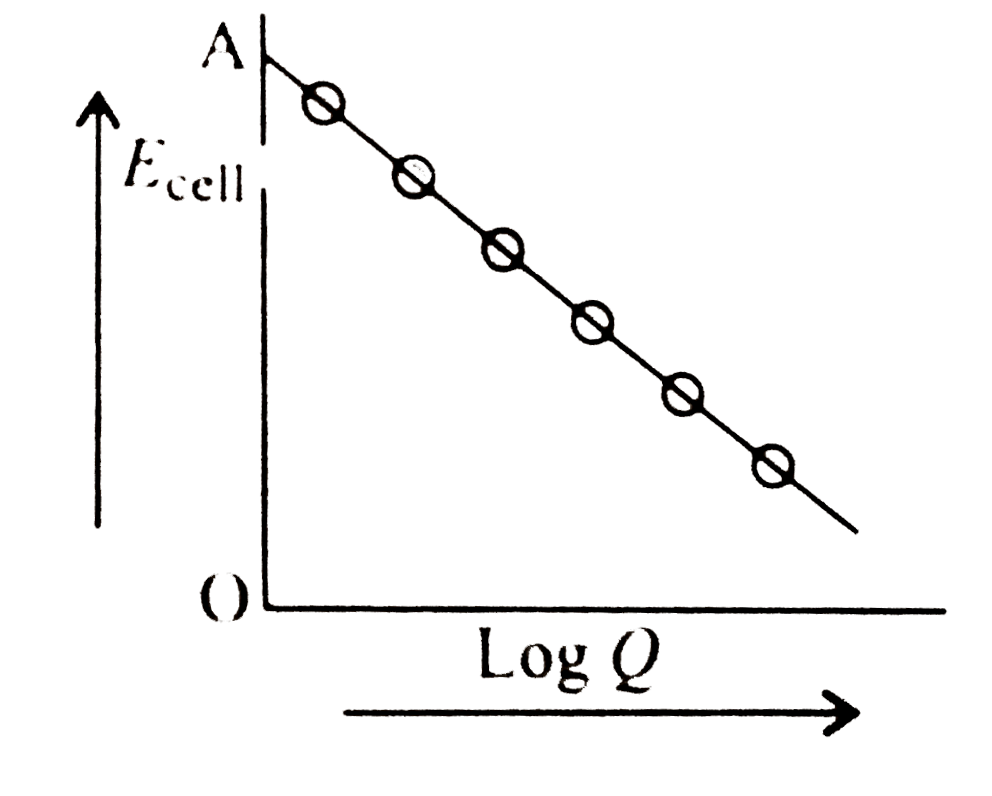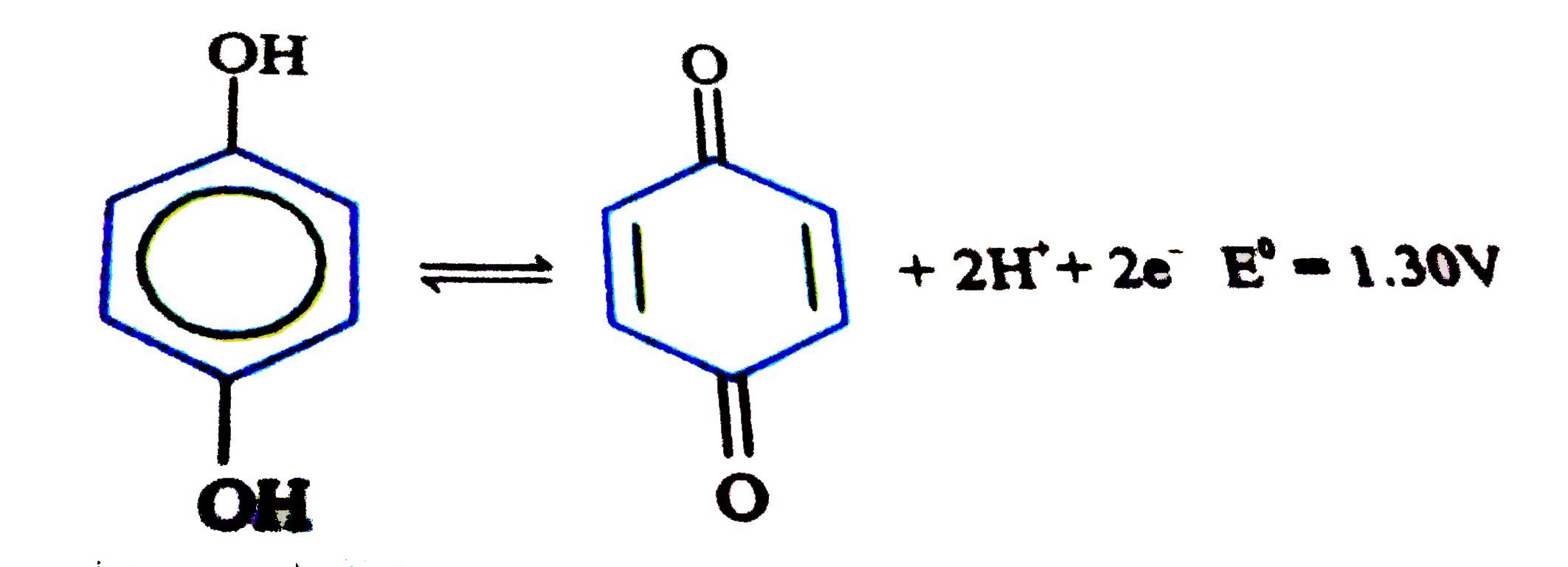Complete Solutions to LEVEL-III of chapter ELECTRO CHEMISTRY of Class 12 book with complete answers and questions
| Class 12 | CHEMISTRY |
| Chapter | ELECTRO CHEMISTRY |
| NARAYANA | LEVEL-III |
| Number Of Questions | 57 |
| Academic Year | 2023-24 |
The time required (approx) to remove electrolytically one half from `0.2` litres of 1M `AgNO_(3)` solution by a current of 1 amp is
View SolutionThe pH of `0.5L` of `1.0"M NaCl"` after the electrolysis for 965 s using `5.0` A current (`100%` efficiency ) is :
View Solution`0.2` faraday charge is passed in 1 litre solution containing `0.1` molar `Fe^(+3)` ions. How many moles of iron get deposited at cathode assuming only iron is reduced in electrolytic process.
`(E_(Fe^(+3)//Fe^(+2))^(0)=0.77"V E"_(Fe^(+2)//Fe)^(0)=-0.44V)`
View SolutionUsing electrolytic method, if cost of production of 10L of oxygen at STP is Rs. x, the cost of production of same volume of hydrogen at STP will be:
View SolutionFor the electrolytic production of `NaClO_(4)` from `NaClO_(3)` according to the reaction `NaClO_(3)+H_(2)O rarr NaClO_(4)+H_(2). ` How many faradays of electricity would be required to produce `0.5 mo l e` of `NaClO_(4)`?
View SolutionWhen `6xx10^(22)` electrons are used in the electrolysis of a metalic salt, `1.6` gm of the metal is deposited at the cathode. The atomic weight of that metal is 57. So oxidation state of the metal in the salt is
View SolutionA copper plate of `10cmxx10cm` and `0.1`cm thickness is to be placted with silver. If the density of Ag is `10.8`g/cc, the number of electrons required for this process is
View SolutionA lead storage battery containing `5.0` L of 1N `H_(2)SO_(4)` solution is operated for `9.65xx10^(5)` s with a steady current of 100 mA. Assuming volume of the solution remaining constant, normality of `H_(2)SO_(4)` will
View SolutionCalculate the quantity of electricity needed in coulombs to reduce one centimole of dichromate in acid medium, to chromic state
View SolutionIn electrolytic reduction of a nitroarene with `50%` current efficiency, `20.50`g of the electric charge. The molar mass of the compound is reduced by `2xx96500C` of electric charge. The molar mass of the compound is:
View SolutionThe quantity of electricity in faradays required to reduce `1.23` gm of nitro benzene to aniline is
View SolutionDuring the electrolysis of acidulated water, the mass of hydrogen obtained is x times that of `O_(2)` and the volume of `H_(2)` is y times that of `O_(2)`. The ratio of y and x is
View SolutionA 1 M solution of `H_2SO_4` is electrolysed. Select correct statement in respect of products obtain at anode and cathode respectively:
Given : `2SO_4^(2-) toS_2O_8^(2-)+2e^-,E^(@)=-1.23V`
`H_2O(l)to2H^+(aq)+1//2O_2(g)+2e^-,E^(@)=-1.23V`
View SolutionThe standard oxidation potential of `Ni//Ni^(2+)` electrode is `0.236 V`. If this is combined with a hydrogen electrode in acid solution, at what `pH` of this solution will be measured e.m.f. be zero at `25^(@)C`? Assume that `[Ni^(2+)] = 1 M` and `P_(H_(2)) = 1 atm`.
View SolutionThe equilibrium constant (K) for the reaction
`Cu(s)+2Ag^(+) (aq) rarr Cu^(2+) (aq)+2Ag(s)`, will be
[Given, `E_(cell)^(@)=0.46 V`]
View SolutionGiven the following limiting molar conductivies at `25^(@)C,, Hcl, 426Omega^(-1)cm^(2)mol^(-1),NaCl, 126Omega^(-1)cm^(2)mol^(-1),NaC`(sodium crotonate) ,`83Omega^(-1)cm^(2)mol^(-1)`. What is the ionization constant of crotonic acid? If the conductivity of a `0.001M` crotonic acid `(HC)` solution is `3.83xx10^(-5)Omega^(-1)cm^(-1)`?
View SolutionThe specific conductance at 289 K of AgCl is `1.826xx10^(-6)ohm^(-1)cm^(-1)`. The ionic conductance of `Ag^(+)` and `Cl^(-)` are `61.92` and `61.92` and `76.36` respectively. What is the solubility of AgCl in water?
View SolutionThe conductivity of 0.1 n NaOH solution is 0.022 S`cm^(-1)`.When equal volume of 0.1 N HCl solution is added, the conductivity of resultant solution is decreased to 0.0055 S `cm^(-1)` . The equivalent conductivity in `Scm^(2)equi^(-1)` of NaCl solution is :
View SolutionEquivalent conductance of 1 M propanoic acid is 10 `ohm^(-1)" cm^(2)eq^(-1)`. pH of the propanpoic acid solution is
View SolutionResistance of a conductvity cell filled with a solution of an electrolyte of concentration 0.1 M is 100 `Omega`. The conductivity of this solution is 1.29 `Sm^(-1)`. Resistance of the same cell when filled with 0.02M of the same solution is `520 Omega`. the molar conductivity of 0.02M solution of the electrolyte will be:
View SolutionThe specific conductance and equivalent conductance of a saturated solution of `BaSO_(4)` are `8xx10^(-5)ohm^(-1)cm^(-1)` and 8000 `ohm^(-1)cm^(2)"equi"^(-1)` respectively. Hence `K_(sp)` of `BaSO_(4)` is
View SolutionAt `25^(@)C` the equivalent conductance of butanoic acid at infinite dilution is `386.6 ohm^(-1)cm^(2)eq^(-1)`. If the ionization consatant is `1.4xx10^(-5)`, calculate equivalent conductance of `0.05` N butanoic acid solution at `25^(@)C(ohm^(-1)cm^(2)eq^(-1))`?
View SolutionA Daniel cell constructed in the laboratory. The voltage observed was `0.9V` instead of `1.10V` of the standard cell. A possible explanation is
View SolutionThe standard reduction potentials of `Cu^(2+)//Cu` and `Cu^(2+)//Cu^(+)` are 0.337 V and 0.153V respectively. The standard electrode potential of `Cu^(+)//Cu` half-cell is
View SolutionGiven the cell reactions
`MX_((s))+e^(-)rarrM_((s))+X_((aq))^(-),E^(@)=0.207V`
and `M_((aq))^(+)+e^(-)rarrM_((s)),E^(@)=0.799V`
The solubility of `MX_((s))` at 298K is
View SolutionEMF of an `H_(2)-O_(2)` fuel cell
View SolutionThe EMF of the cell
`Pt,Cl_(2(g))(P_(1)atm)|Cl_((aq))^(-)(1M)|Cl_(2(g)))P_(2)Atm)`,
Pt will be positive when :
View SolutionStandard electrode potentials are
`Fe^(2+)//Fe, E^(@) = -0.44 V`
`Fe^(3+)//Fe^(2+), E^(@) = +0.77 V`
If `Fe^(3+), Fe^(2+)`, and Fe block are kept together, then
View SolutionAt any instant during the reaction `Zn+Cu^(++)rarrZn^(++)+Cu` Occurring in an open beaker at temperature T
View Solution`Zn+Cu^(2+)(aq)hArrCu+Zn^(2+)(aq).`
Reaction quotient is `Q=([Zn^(2+)])/([Cu^(2+)])` . Variation of `E_(cell)` with log `Q` is of the type with `OA=1.10` `V.E_(cell) ` will be `1.1591V` when
View SolutionFor the half cell

At pH = 3 electrode potential is
View SolutionFind the equilibrium constant at `298K` for the reaction,
`Cu^(2+)(aq) +In^(2+)(aq)hArr Cu^(+)(aq) +In^(3+)(aq)`
Given that `E_(Cu^(2+)//Cu^(+))^(@) =0.15V, E_(In^(3+)//In^(-))^(@) =- 0.42V, E_(In^(2+)//In^(+))^(@) =- 0.40V`
View SolutionThe standard reduction potential for `Cu^(2+)|Cu` is `+0.34V`. Calculate the reduction potential at`pH=14` for the above couple . `K_(sp)` of `Cu(OH)_(2)` is `1.0xx10^(-19)`
View SolutionDuring discharging of lead-storage acid battery following reaction takes place:
`Pb(S)+PbO_(2)(S)+2H_(2)SO_(4)`
`rarr2PbSO_(4)(S)+2H_(2)O`
If `2.5` amp of current is drawn for 965 minutes, `H_(2)SO_(4)` consumed is :
View Solution`Zn|Zn^(2+)(c_(1)) || Zn^(2+)(c_(2))|Zn`. For this cell `DeltaG` is negative if `:`
View SolutionThe oxidation potential of hydrogen electrode `H_(2)//H_(2)O^(+)` (aq) will be greater than zero if,
View SolutionThe reduction potential of hydrogen half cell will be negative if :
View SolutionA galvanic cell is compsed of two hydrogen electrodes, one of which is a standard one. In which of the following solutions should the other electrode be immersed to get maximum emf?
`K_(a)(CH_(3)COOH) = 2 xx 10^(-5)` ,`K_(a)(H_(3)PO_(4)) = 10^(-3)`.
View SolutionThe following facts have been observed:
`2X^(-)+Y_(2)rarr2Y^(-)+X_(2)`
`2W^(-)+Y_(2)rarr` No reaction `2Z^(-)+X_(2)rarr2X^(-)+Z_(2)`
Which of the following sequence is true?
View SolutionTwo weak acid solutions `HA_(1)` and `HA_(2)` with the same concentration and having `pK_(a)` values 3 and 5 are placed in contact with hydrogen electrode `(1 atm ` and `25^(@)C)` and are interconnected through a salt bridge. Find the `EMF` of the cell.
View SolutionThe standard reduction potential for `Zn^(2+)//Zn, Ni^(2+)//Ni` and `Fe^(2+)//Fe` are `-0.76, -0.23` and `-0.44V` respectively. The reaction `X + Y^(2) rarr X^(2+) + Y` will be spontaneous when:
View SolutionWhat will be the emf for the given cell ?
`Pt|H_(2)(g,P_(1))|H^(+)(aq)|H_(2)(g,P_(2))|Pt`
View SolutionThe negative Zn pole of Daniell cell, sending a constant current through a circuit, decreases in mass by `0.13` g in 30 minutes. If the chemical equivalent of Zn and Cu are `32.5` and `31.5` respectively, the increase in the mass of the positive Cu pole in this time is
View SolutionGiven the data at `25^(@)C`
`Ag+I^(-)rarrAgl+e^(-)" "E^(@)=0.152V`
`Ag rarrAg^(+)+e^(-)E^(@)=-0.800V`
What is the value of `log K_(sp)` for AgI?
View SolutionIn a fuel cell methanol is used as fuel and oxygen gas is used as an oxidizer. The reaction is `:`
`CH_(3)OH_((l))+(3)/(2)O_(2(g))rarr CO_2((g))+2H_(2)O_((l))`
At `298K` standard Gibb's energies of formation for `CH_(3)OH(l), H_(2)O(l)` and `CO_(2)(g)` are `-166.2,-237.2` and `-394.4kJ mol^(-1)` respectively. If standard enthalpy of combustion of methanol is `-726kJ mol^(-1)`, efficiency of the fuel cell will be `:`
View SolutionThe Gibbs energy for the decomposition of `Al_(2)O_(3)` at `500^(@)C` is as follows:
`(2)/(3)Al_(2)O_(3) rarr (4)/(3)Al + O_(2), Delta_(r)G = +966kJ mol^(-1)`
The potential difference needed for electrolytic reeduction of `Al_(2)O_(3)` at `500^(@)C` is at least:
View SolutionThe following are some statements about Voltaic cell
I) Chemical energy converted into electrical energy
II) Electrons flows from anode to cathode
III) Oxidation occurs at anode
IV) Anode is negative and cathode is positive
The correct answer is
View SolutionIn an electrochemical process, a salt bridge is used:
View SolutionDuring the working of a galvanic cell and with the passage of time :
a) spontaneity of the cell reaction decreases, `E_(cell)` decreases b) reaction quotient Q decreases, `E_(cell)` decreases
c) Reaction quotient Q increases, `E_(cell)` decreases
d) At equilibrium, `Q =K_(e),E_(cell)=0`
Corrent statements are
View SolutionFollowing are some of the facts about a dry cell
I : It is alos called Leclanche cell
II : It is also called Daniel cell
III : Electrolyte is a moist paste of `NH_(4)Cl` and `ZnCl_(2)` in starch
IV : Cathodic reaction is
`2MnO_(2)(s)+2NH_(4)^(+)(aq)+2e^(-)`
`rarrMn_(2)O_(3)(s)+2NH_(3)(g)+H_(2)O(l)`
Select correct facts :
View SolutionThe following are some statements about electrolysis
I) Involves flow of electrons from anode to cathode
II) Involves no chemical reaction at electrodes
III) Oxidation occurs at anode and reduction at cathode
IV) Anions migrate towards cathods
The correct combination is
View SolutionFor the following cell reaction,
`Ag | Ag^(+) | AgCl | Cl^(-) | Cl_(2) , Pt`
`Delta G_(f)^(0) (AgCl) =-109 kJ//mol`
`Delta G_(f)^(0) (Cl ) = -129kJ//mol`
`Delta G_(f)^(0) (Ag^(+)) = 78 kJ//mol`
`E^@` of the cell is
View SolutionThe half cell reaction for rusting of iron are:
`2H^(+)+2e^(-)+(1)/(2)O_(2)rarrH_(2)O(l), E^(@)=+1.23V`
`Fe^(2+)+2e^(-)rarrFe(s), E^(@)=-0.44V`
`DeltaG^(@)` (in KJ) for the reaction is
View SolutionThe metal that cannot obtained by electrolysis of an aqueous solution of its salts is `:`
View SolutionResistance of ` 0.2 M` solution of an electrolue is ` 50 Omega`. The specific conductance of the solution is ` 1.4 S m^^(-1)`. The resistance of `0.5` M solution of the same electrolyte is `280. Omega`. The molar conducitivity of ` 0.5 M` solution of the electrolyte is ` S m^2 "mol"^(-1)` is.
View SolutionGiven `E_("Cr_(2)O_(7)^(2-)//Cr^(3+))^(@)=1.33V,E_(MnO_(4)^(-)//Mn^(2+))^(@)=1.51V`
Among the following, the strongest reducing agent is `E_(Cr^(3+)//Cr)^(@)=-0.74V^(x),E_(MnO_(4)^(-)//Mn^(2+))^(@)=1.51V`
`E_(Cr_(2)O_(7)^(2-)//Cr^(3+))^(@)=1.33V,E_(Cl//Cl^(-))^(@)=1.36V`
Based on the data given above strongest oxidising agent will be
View SolutionThe reduction potential of hydrogen half cell will be negative if :
View Solution
LEVEL-III questions and complete solutions for chapter ELECTRO CHEMISTRY of NARAYANA CHEMISTRY (HINGLISH) of Class 12